· learning · 4 min read
The Importance of Firestopping in Commercial and Residential Buildings
Firestopping is crucial in both commercial and residential buildings as it can prevent fire from spreading and minimize damage to the structure.

Why should we care about firestopping when constructing residential and commercial buildings?
Firestopping is an essential part of building safety that is often overlooked or underestimated. It is the process of sealing openings in walls, floors, and ceilings to prevent the spread of fire, smoke, and toxic gases in the event of a fire. Firestopping is crucial in both commercial and residential buildings as it can prevent fire from spreading and minimize damage to the structure.
In commercial buildings, firestopping is necessary for compliance with building codes and regulations. Fire safety codes require that all openings in walls and floors, including those made for pipes, ducts, and conduits, must be sealed with fire-rated materials. Failure to comply with these codes can result in fines and legal liabilities for building owners and contractors. Moreover, in the event of a fire, a lack of proper firestopping can lead to significant damage, loss of property, and endangerment of human life.
In residential buildings, firestopping is equally important. Residential buildings typically have smaller floor plans, which means that fires can spread quickly from one unit to another. Firestopping in residential buildings is especially critical because residents may not be able to evacuate the building quickly, especially if they have mobility issues or are elderly. Proper firestopping can slow the spread of fire, allowing more time for residents to escape and firefighters to arrive.
Moreover, the use of fire-resistant materials in firestopping can improve the safety of the building occupants. Fire-resistant materials can delay the spread of fire and reduce the amount of smoke and toxic gases produced. This can give building occupants more time to evacuate and reduce the risk of inhalation of toxic fumes. One of the main reasons why firestopping is so important is because it helps to contain a fire to its point of origin. In the event of a fire, flames, smoke, and toxic gases can quickly spread through openings in walls, floors, and ceilings. Firestopping helps to seal these openings, preventing the spread of fire and giving occupants more time to evacuate the building. This can be especially critical in larger commercial buildings where it may take longer for firefighters to arrive on the scene.
Another reason why firestopping is essential is that it helps to protect the structural integrity of the building. Fires can weaken structural components such as walls, floors, and roofs, making them more susceptible to collapse. By preventing the spread of fire, firestopping can help to minimize the damage caused by a fire and reduce the risk of structural failure.
Firestopping also plays a critical role in maintaining compliance with building codes and regulations. Building codes require that all openings in walls, floors, and ceilings be sealed with fire-rated materials. Failure to comply with these codes can result in fines and legal liabilities for building owners and contractors. Furthermore, if a fire occurs in a building that is not up to code, insurance companies may refuse to cover the damages.
Finally, firestopping can help to reduce the risk of smoke inhalation and other health hazards associated with fires. Smoke inhalation is a leading cause of death in fires, and toxic gases produced by burning materials can cause long-term health effects. By using fire-resistant materials in firestopping, building owners can help to reduce the amount of smoke and toxic gases produced, making it easier for occupants to evacuate and reducing the risk of long-term health effects.
In summary, firestopping is a critical part of building safety that should never be overlooked. It helps to prevent the spread of fire, minimize damage, maintain compliance with building codes and regulations, and protect the health and safety of building occupants. Building owners and contractors should ensure that firestopping is included in their building plans and carried out by qualified professionals to ensure the safety of all occupants in the event of a fire.